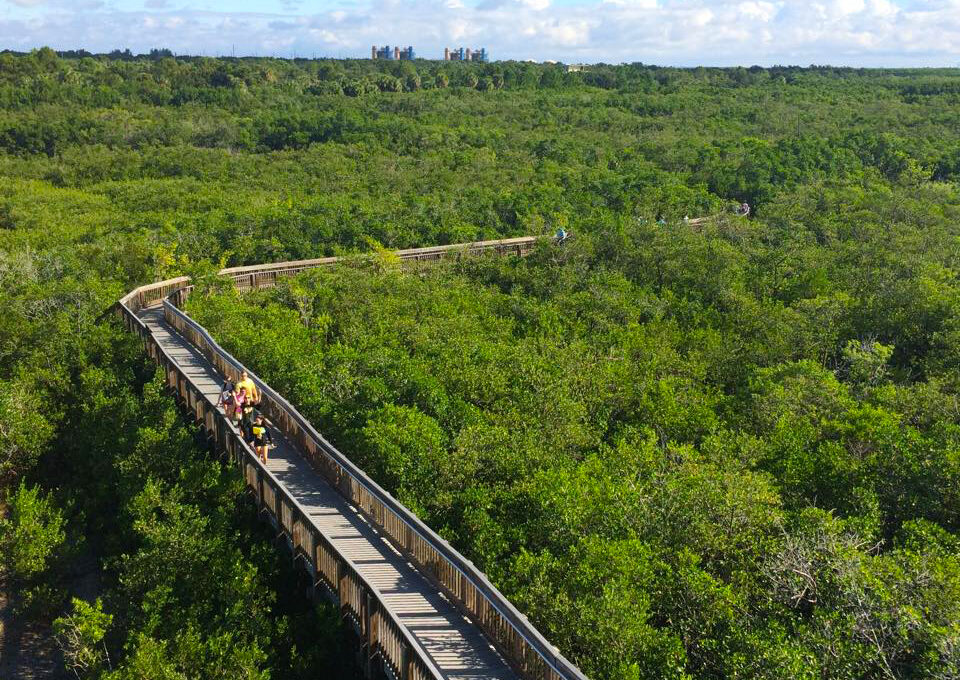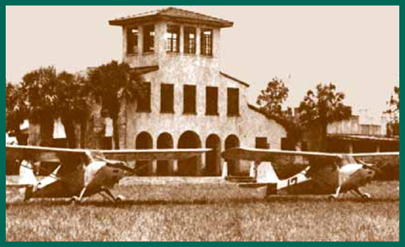
When you’re strolling along peaceful boardwalks or paddling serene canoe trails at Weedon Island Preserve, it’s difficult to imagine its tumultuous past – and how lucky we are to have preserved this small slice of paradise.
At 3,700 acres preserved within the bustling Gandy corridor, Weedon Island’s strategic location has made it a mecca for Indigenous peoples, land developers, even airlines and speakeasies through a somewhat chaotic past where grand plans often disintegrated.
Its earliest recorded settlers were the Indigenous people who probably arrived in about 5000 BCE, as shown by stone artifacts including knives and drills. Thriving upon abundant food sources, they became part of one of the most advanced communities in the southeast, with distinctive ornate Weedon Island pottery first uncovered by Smithsonian archeologists in the 1920s. They also built what has become the longest prehistoric canoe ever found in Florida, a 40-foot pine dugout with a raised bow that indicates it was used to navigate open waters.
Archaeologists continue to uncover significant artifacts dating back to about 200 BCE but the first written records of Weedon Island occurred in 1842 when a settler claimed 160 acres as a homestead. Several owners later, it was gifted to Leslie Weedon as a wedding present from his father-in-law in 1898. The Weedons, who lived in Tampa where he practiced medicine, built a weekend home there.
They sold the land, except for one house lot, to Eugene Elliott, a colorful land speculator who used the prehistoric Indian mounds as a drawing card. (He probably planted artifacts to entice a Smithsonian archeologist to visit.) In the midst of prohibition, he also opened the San Remo Club, a dance hall that was actually a speakeasy. What better way to entice prospective buyers to pull out their wallets than to serve them alcohol?
But the bottom fell out of Florida’s real estate market in 1926 and the bank foreclosed on the property. By 1929, Fred Blair began building an airport that eventually housed the predecessor to Eastern Airlines. Blair joined another group of investors to create the Sun Haven Movie studio in the refurbished San Remo Club, shooting three films before the federal government closed down the studio for not paying its taxes.
The airport continued to thrive with flights to Tampa and Daytona Beach – and connections that allowed passengers to fly to New York in just 24 hours. More tax problems, this time with the City of St. Petersburg, caused the city to foreclose and the airport shut down.
It reopened as a training base for Army and Navy pilots at the beginning of World War II, but afterward, competition with the nearby and more easily accessible St. Petersburg-Clearwater Airport began taking business away and it eventually closed, leaving just an overgrown runway. By 1970, the wooden bridge connecting the island with the mainland – the only remaining wooden bridge in Pinellas County – was cut in the middle for safety reasons.
After years of neglect and piled-up trash, the owners of most of the land (excluding the Bartow Power Plant) agreed to sell their properties to the state through the Endangered Lands Acquisition Act in 1974 – the first purchase made with the innovative funding source. The future looked bright, until the state announced that negotiations were underway with Florida Power to purchase part of their property to build a prison. Public outcry stymied that proposal, then the state announced that it was reclassifying Weedon as a recreational area rather than a preserve.
Again, public pressure prevailed and the state agreed to protect the land rather than develop it, until 1992 when the state, facing financial pressure, placed Weedon Island on a list of parks to be closed.
But, to quote William Shakespeare, all’s well that ends well. As the state parks department pondered its options, Pinellas County intervened and asked the state for a long-term lease. Once that agreement was in place, the county negotiated a deal with the City of St. Petersburg and the Southwest Florida Water Management District to finance improvements for public access and to continue the restoration of the preserve.
For Barbara Sheen Todd, then chair of the Pinellas Board of County Commissioners, Weedon Island was the perfect opportunity to show taxpayers how beneficial the just-approved Penny for Pinellas could be. “It was a personal decision on my part that Pinellas County – the most densely populated county in the state – should save whatever green spaces we possibly could,” Todd recalls. “We created a non-profit organization, Friends of Weedon Island, to hear how people thought it should be developed.”
The overwhelming consensus was to keep the land as natural as possible and to avoid developing it into a recreational complex with sports fields. The county soon transferred the property from its parks department to its environmental lands division and volunteers stepped up to make a difference. Boy Scouts volunteered over 3,000 hours to blaze trails, pick up debris and build benches.
Today, nearly four miles of trails – including two miles of disability-accessible boardwalks and a 45-foot observation tower – meander through the protected lands of the preserve. A fishing pier and well-marked paddling trail make it easy to explore the watery world, including the amazing mangrove tunnels that crisscross the island, dredged remains of mosquito-control efforts.

The Cultural and Natural History Center opened in 2001, the first facility in the region to focus on Native Americans and highlight the island’s prehistoric culture and traditions. Designed with the help of Native American consultants, the building features a curved roof that resembles wings and is open to seven directions recognized by the First People: upper, lower and present worlds, as well as the four compass points.
For most visitors, the first indication that the building wasn’t designed using traditional techniques is the east-facing entrance – even though the parking lot is on the west. Walking around the building instead of directly into it also offers visitors a chance to wind down and open up to the natural beauty of the preserve.
Over the last two decades, archaeologists have found more pre-Columbian artifacts. Researchers from the University of South Florida (USF) and the Alliance for Weedon Island Archaeological Research and Education (AWIARE), a non-profit with a mission to promote and facilitate long-term archaeological research, scientific exploration, and public education at the Weedon Island Preserve and the adjacent Gulf Coast region, have uncovered a house floor, intensive craft areas where people were producing shell beads, as well as a number of other living areas. “Innovative and exciting archaeological research is ongoing with a new generation of archaeologists exploring the Weedon Island preserve and the larger Tampa Bay region,” said Dr. John W. Arthur, president of AWIARE and an anthropology professor at USF St. Petersburg. “This will tell new stories about the earliest inhabitants of the region.”
The preserve is now truly a Treasure of Tampa Bay, showing what can happen when a community comes together to preserve one of the most beautiful – and archaeologically significant – places in the state.
Treasures of Tampa Bay is an occasional feature in Bay Soundings that looks at the remarkable accomplishments of local governments, agencies and volunteer groups who have made the Tampa Bay estuary an international success story. By highlighting these achievements, we hope to encourage continued efforts to preserve, restore and protect Tampa Bay and its ecosystems as our region continues to grow. To suggest people or places, please contact editor@baysoundings.com
The historical information in this article is a much-shortened version of the Weedon Island Story, written and published by the Pinellas County Parks Department.


